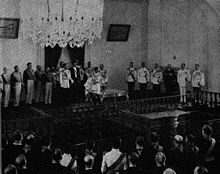Senate (Iran)
The Senate ( Persian کاخ مجلس سنا Kach-e Madschles-e Sena ) was the second chamber of the Iranian parliament according to the Iranian constitution, which was valid until 1979. After the Islamic Revolution , Iran received a new constitution that abolished the Senate.
function
The constitution of 1906 formulated the mandate of the Senate in Article 46 as a second chamber that has to approve all laws and resolutions of the first parliamentary chamber, the Majles . The Senate also has the right to initiate legislation. If a bill submitted to the Senate finds a majority, it must be submitted to the Majles for approval. Article 47 stipulated that “as long as the Senate has not met, laws passed by the Majles will become law through the signature of the Shah”. Because of this article, the formation of a Senate was repeatedly postponed.
Electoral law
The electoral law for the election of the Senate was only passed by the Majles on May 18, 1949 at the urging of Shah Mohammad Reza Pahlavi . Half of each 30 senators are elected by an indirect election through electors and 30 are appointed by the Shah. The Senate therefore consists of 60 senators. The Senate's legislative period is six years (later four years). After three (later 2) years, half of the senators leave the Senate after a lottery and must therefore be redetermined. Re-election is possible. Article 45 of the Iranian Constitution states that the election of senators should be chosen from among the well-informed, astute, pious and respected personalities of the kingdom. The circle of eligible persons was limited to high clergy, former army officers, scientists and scholars, senior civil servants as well as large landowners and merchants with a minimum tax revenue of the equivalent of 25,000 euros (as of 1965). According to the electoral law, a senator had to be an Iranian citizen, known in his constituency, at least 40 years, Muslim and of good repute.
President
Presidents of the Senate were:
- Ebrahim Hakimi , August 19, 1951 - March 1, 1957, Progressive Party
- Seyyed Hassan Taqizadeh , March 1, 1957 - September 1, 1960, Liberal Party
- Mohsen Sadr , September 11, 1960 - September 11, 1964, Socialist Party
- Jafar Sharif-Emami , September 11, 1964 - March 24, 1978, Rastachiz party
- Mohammad Sadschadi, March 24, 1978 - February 10, 1979, National Front
Interruption of meetings under Prime Minister Mossadegh from October 25, 1952
The Senate's activities were suspended from October 27, 1952 during Ebrahim Hakimi's presidency. While Prime Minister Mohammad Mossadegh was largely certain of the Majles' support for his reform policy , the Senate, which was dominated by the Iranian elite, was in sharp opposition to Mossadegh's anti-British foreign and liberal domestic policy. On October 23, 1952, the Senate refused to approve three parliamentary bills. The bills that were rejected were the Enabling Act , the Act to Release Prime Minister Ali Razmara's Murderer , Khalil Tahmasbi, and the Act to Confiscate the Property of Previous Prime Minister Ahmad Qavam .
The National Front then criticized the Senate as an "aristocratic club" and caused its dissolution by the Majles passing a law on October 23, 1952 that shortened the Senate's term of office from six to two years. After a conversation with the Shah, in which Mossadegh promised an early Senate election, the Shah approved the law on October 25, 1952. However, Mossadegh's government neither passed an electoral reform nor held new elections to the Senate.
After the fall of Mossadegh, his successor Prime Minister Fazlollah Zahedi and the Shah initiated new elections for the Senate and the Majles in early 1954. The elections were held under martial law from the beginning of February and were accompanied by allegations of manipulation and election fraud. The legislative term of the Senate and Parliament was changed to four years.
Senate building
The Senate building was designed by Heydar Ghiaï. The construction was completed in 1955. Following the dissolution of the Senate, the building is now used by the Guardian Council .
literature
- Heydar Ghiaī: The Senate House Iran. Designed in the year 2514 shahanshahi. Photographs by Jérôme Ducrot. Text and interviews established and edited by Max Gérard. Draeger Paris, 1976.
Individual evidence
- ↑ Ali Akbar Schamsse Aram: elements of the current Iranian system of government. Heidelberg 1966, p. 39 (Heidelberg, Universität, Dissertation, July 19, 1966).
- ↑ Habib Ladjevardi: Constitutional Government and Reform under Mussaddiq. In: James A. Bill et al. Wm. Roger Louis (ed.): Musaddiq, Iranian Nationalism and Oil . University of Texas Press, Austin 1988, pp. 73f.
- ↑ Ervand Abrahamian: Iran between two Revolutions. Princeton UP, 2nd ed., Princeton 1985, p. 273.
- ↑ Sepehr Zabih: The Mossadegh Era: Roots of the Iranian Revolution . Lake View Press, Chicago 1982, p. 78.
- ↑ Habib Ladjevardi: Constitutional Government and Reform under Mussaddiq. In: James A. Bill et al. Wm. Roger Louis (ed.): Musaddiq, Iranian Nationalism and Oil . University of Texas Press, Austin 1988, p. 74.
- ^ Houchang E. Chehabi: Iranian Politics and Religious Modernism. The Liberation Movement of Iran under the Shah and Khomeini. IBTauris, London 1990, pp. 134-136.

